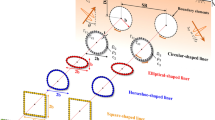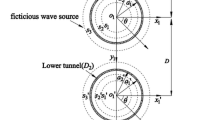Abstract
The ground surface response was obtained in the presence of twin horseshoe-shaped lined tunnels embedded in a linear elastic half-space, subjected to obliquely propagating incident plane SH-waves. A numerical approach known as direct half-plane time-domain boundary element method was used to prepare the model. First, the heterogeneous problem was decomposed into three parts, two closed linings and a double-hole half-plane. Then, the method was applied to each part to compute the required matrices. Finally, the problem was solved by satisfying the continuity conditions at the interfaces. After solving a verification example, an advanced parametric study was carried out for obtaining the surface response with shallow twin horseshoe-shaped lined tunnels as synthetic seismograms and 3-D amplification patterns. Some intended parameters were also considered to illustrate the ground response including the horizontal/vertical overlapping of the tunnels, depth and distance between them and incident wave angle. To summarize the results, some graphs were presented to obtain the maximum amplification ratio of the surface. Numerical results showed that the existence of twin horseshoe-shaped tunnels could amplify the ground surface response up to three and half times the free-field movement at dimensionless frequencies greater than one. Also, achievements indicated that the greater role of vertically overlapped tunnels in creating safe areas on the surface compared to the horizontally placed tunnels. The results can be practically used in clarifying seismic codes in the field of urban transportation geotechnics.









Similar content being viewed by others
Abbreviations
- A, B :
-
The matrices whose elements are corresponding to the unknown and known boundary values, respectively
- a max :
-
The maximum displacement of the Ricker wavelet
- b :
-
The outer radius of the tunnel
- b (x, y, t):
-
Anti-plane body force at the point (x, y) and current time t
- c :
-
Shear wave velocity
- c (ξ):
-
Boundary element coefficients
- f p :
-
Predominant frequency of the Ricker wavelet
- G, H :
-
The matrices whose elements are obtained by integration over u* and q*, respectively
- H (.):
-
Heaviside function
- J :
-
Jacobian transformation
- M :
-
Number of elements used on the boundary
- N :
-
Number of time steps used on the time axis
- n :
-
Normal vector, perpendicular to the boundary
- q* :
-
Traction fundamental solution
- q, Q :
-
Traction fields on the boundary and traction kernels, respectively
- R :
-
The effect of past dynamic history on the current time
- t, τ :
-
Current and preceding time, respectively
- t 0 :
-
Time-shift parameter of the Ricker wavelet
- u* :
-
Displacement fundamental solution
- u, U :
-
Displacement fields on the boundary and displacement kernels, respectively
- u ff :
-
Free-field displacements on the ground surface
- X, Y :
-
The vectors of the unknown and known variables
- α inc , α ref :
-
Phase of incident and reflected waves, respectively
- Γ :
-
Boundary of the problem
- Δt :
-
Time step
- η :
-
Dimensionless frequency
- θ :
-
Incident wave angle
- κ :
-
Local coordinate system component
- μ :
-
Shear modulus of the domain
- ρ :
-
Density of the domain
- ω :
-
Angular velocity
- BEM:
-
Boundary element method
- BIE:
-
Boundary integral equation
- DASBEM:
-
Dynamic analysis of structures by boundary element method
- FBEM:
-
Full-plane boundary element method
- FDM:
-
Finite difference method
- FEM:
-
Finite element method
- HBEM:
-
Half-plane boundary element method
References
Ba Z, Yin X (2016) Wave scattering of complex local site in a layered half-space by using a multi-domain IBEM: incident plane SH waves. Geophys J Int 205:1382–1405
Balendra T, Thambiratnam DP, Koh CG, Lee SL (1984) Dynamic response of twin circular tunnels due to incident SH-waves. Earthq Eng Struct Dyn 12:181–201
Belytschko T, Chang HS (1988) Simplified direct time integration boundary element method. J Eng Mech 114(1):117–134
Benites R, Aki K, Yomogida K (1992) Multiple scattering of SH waves in 2-D media with many cavities. Pure Appl Geophys 138(3):353–390
Besharat V, Davoodi M, Jafari MK (2012) Effect of underground structures on free-field ground motion during earthquakes. In: 15th World conference on earthquake engineering, Lisbon, Portugal
Beskos DE (1987) Boundary element methods in dynamic analysis. Appl Mech Rev 40(1):1–23
Brebbia CA, Dominguez J (1989) Boundary elements an introductory course. Computational Mechanics Publications, Southampton
Crouch SL, Starfield AM (1983) Boundary elements methods in solid mechanics. Department of Civil and Mineral Engineering, University of Minnesota
Datta SK, Shah AH (1982) Scattering of SH waves by embedded cavities. Wave Motion 4:265–283
Dominguez J (1993) Boundary elements in dynamics. Computational Mechanics Publications, Southampton
Dominguez J, Meise T (1991) On the use of the BEM for wave propagation in infinite domains. Eng Anal Bound Elem 8(3):132–138
Faccioli E, Maggio F, Paolucci R, Quarteroni A (1997) 2D and 3D elastic wave propagation by a pseudo-spectral domain decomposition method. J Seismolog 1:237–251
Gao Y, Dai D, Zhang N, Wu Y, Mahfouz AH (2016) Scattering of plane and cylindrical SH waves by a horseshoe shaped cavity. J Earthq Tsunami 10(2):1–23
Gelagoti F, Kourkoulis R, Anastapoulos I, Gazetas G (2012) Nonlinear dimensional analysis of Trapezoidal valleys subjected to vertically propagating SV waves. Bull Seismol Soc Am 102(3):999–1017
Hasheminejad SM, Kazemirad S (2008) Dynamic response of an eccentrically lined circular tunnel in poroelastic soil under seismic excitation. Soil Dyn Earthq Eng 28:277–292
Hirai H (1988) Analysis of transient response of SH wave scattering in a half-space by the boundary element method. Eng Anal 5(4):189–194
Jiang LF, Zhou XL, Wang JH (2009) Scattering of a plane wave by a lined cylindrical cavity in a poroelastic half-space. Comput Geotech 36:773–786
Kamalian M, Gatmiri B, Sohrabi-Bidar A, Khalaj A (2007) Amplification pattern of 2D semi-sine shaped valleys subjected to vertically propagating incident waves. Int J Numer Methods Biomed Eng 23(10):871–887
Kamalian M, Jafari MK, Sohrabi-Bidar A, Razmkhah A (2008) Seismic response of 2D semi-sine shaped hills to vertically propagating incident waves: amplification patterns and engineering applications. Earthq Spectra 24(2):405–430
Kamalian M, Jafari MK, Sohrabi-Bidar A, Razmkhah A, Gatmiri B (2006) Time-domain two-dimensional site response analysis of non-homogeneous topographic structures by a hybrid FE/BE method. Soil Dyn Earthq Eng 26(8):753–765
Kattis SE, Beskos DE, Cheng HD (2003) 2D dynamic response of unlined and lined tunnels in poroelastic soil to harmonic body waves. Earthq Eng Struct Dyn 32:97–110
Kolymbas D (2005) Tunneling and tunnel mechanics. Springer, Berlin
Lee VW (1977) On the deformations near circular underground cavity subjected to incident plane SH-waves. In: Proceedings of symposium of applications of computer methods in engineering conference University of Southern California, Los Angeles, pp 951–962
Lee VW, Chen S, Hsu IR (1999) Anti-plane diffraction from canyon above subsurface unlined tunnel. J Eng Mech 125(6):668–675
Lee VW, Trifunac MD (1979) Response of tunnels to incident SH waves. J Eng Mech Div 105(4):643–659
Liu Z, Liu L (2015) An IBEM solution to the scattering of plane SH-waves by a lined tunnel in elastic wedge space. Earthq Sci 28(1):71–86
Liu Z, Wang Y, Liang J (2016) Dynamic interaction of twin vertically overlapping lined tunnels in an elastic half space subjected to incident plane waves. Earthq Sci 29(3):185–201
Luco JE, De-barros FCP (1994) Dynamic displacements and stresses in the vicinity of a cylindrical cavity embedded in a half-space. Earthq Eng Struct Dyn 23(3):321–340
Manolis GD, Beskos DE (1983) Dynamic response of lined tunnels by an isoparametric boundary element method. Comput Methods Appl Mech Eng 36:291–307
Manoogian ME (2000) Scattering and diffraction of SH waves above an arbitrarily shaped tunnel. ISET J Earthq Technol 37(1–3):11–26
Narayan JP, Kumar D, Sahar D (2015) Effects of complex interaction of rayleigh waves with tunnel on the free surface ground motion and the strain across the tunnel-lining. Nat Hazards 79(1):479–495
Okumura T, Takewaki N, Shimizu K, Fukutake K (1992) Dynamic response of twin circular tunnels during earthquakes. Earthq Eng Struct Dyn 840:181–191
Panji M, Ansari B (2017) Modeling pressure pipe embedded in two-layer soil by a half-plane BEM. Comput Geotech 81:360–367
Panji M, Ansari B (2017) Transient SH-wave scattering by a lined tunnel embedded in an elastic half-plane. Eng Anal Bound Elem 84:220–230
Panji M, Asgari Marnani J, Tavousi Tafreshi Sh (2011) Evaluation of effective parameters on the underground tunnel stability using BEM. J Struct Eng Geotech 1(2):29–37
Panji M, Hasanlouyi SM (2018) Time-history responses on surface by regularly distributed enormous embedded cavities: incident SH-waves. Earthq Sci 31:137–153
Panji M, Kamalian M, Asgari Marnani J, Jafari MK (2013) Transient analysis of wave propagation problems by half-plane BEM. Geophys J Int 194(3):1849–1865
Panji M, Kamalian M, Asgari Marnani J, Jafari MK (2013) Amplification pattern of semi-sine shaped valleys subjected to vertically propagating incident SH waves. J Comput Methods Eng 32(2):87–111
Panji M, Kamalian M, Asgari Marnani J, Jafari MK (2014) Analyzing seismic convex topographies by a half-plane time-domain BEM. Geophys J Int 197(1):591–607
Panji M, Kamalian M, Asgari Marnani J, Jafari MK (2014) Anti-plane seismic response from semi-sine shaped valley above embedded truncated circular cavity: a time-domain half-plane BEM. Int J Civ Eng 12(2):193–206
Panji M, Koohsari H, Adampira M, Alielahi H, Asgari Marnani J (2016) Stability analysis of shallow tunnels subjected to eccentric loads by a boundary element method. J Rock Mech Geotech Eng 8:480–488
Parvanova SL, Dineva PS, Manolis GD, Wuttke F (2014) Seismic response of lined tunnels in the half-plane with surface topography. Bull Earthq Eng 12(2):981–1005
Rabeti MM, Baziar MH (2016) Seismic ground motion amplification pattern induced by a subway tunnel: shaking table testing and numerical simulation. Soil Dyn Earthq Eng 83:81–97
Ricker N (1953) The form and laws of propagation of seismic wavelets. Geophysics 18(1):10–40
Shen Y, Gao B, Yang X, Tao SJ (2014) Seismic damage mechanism and dynamic deformation characteristic analysis of mountain tunnel after Wenchuan earthquake. Eng Geol 180:85–98
Shi S, Han F, Wang Z, Liu D (1996) The interaction of plane SH-waves and non-circular cavity surfaced with lining in anisotropic media. Appl Math Mech 17(9):855–867
Smerzini C, Aviles J, Paolucci R, Sanchez-Sesma FJ (2009) Effect of underground cavities on surface earthquake ground motion under SH wave propagation. Earthq Eng Struct Dyn 38(12):1441–1460
Stamos AA, Beskos DE (1995) Dynamic analysis of large 3-D underground structures by the BEM. Earthq Eng Struct Dyn 24:917–934
Takemiya H, Fujiwara A (1994) SH-wave scattering and propagation analyses at irregular sites by time domain BEM. Bull Seismol Soc Am 84(5):1443–1455
Telles JCF, Brebbia CA (1980) Boundary element solution for half-plane problems. Int J Solids Struct 12:1149–1158
Wang WL, Wang TT, Su JJ, Lin CH, Seng CR, Huang TK (2001) Assessment of damage in mountain tunnels due to the Taiwan Chi–Chi earthquake. Tunn Undergr Space Technol 16(3):133–150
Wu G, Finn WDL (1997) Dynamic nonlinear analysis of pile foundations using finite element method in the time domain. Can Geotech J 34(1):44–52
Wu R, Xu JH, Li C, Wang ZL, Qin S (2015) Stress distribution on mine roof with the boundary element method. Eng Anal Bound Elem 50:39–46
Xiao B, Carter JP (1993) Boundary element analysis of anisotropic rock masses. Eng Anal Bound Elem 11:293–303
Yang L, Sterling RL (1989) Back analysis of rock tunnel using boundary element method. J Geotech Eng 115(8):1163–1169
Ye GW, Sawada T (1989) Some numerical properties of boundary element analysis using half-plane fundamental solutions in 2-d elastostatics. J Comput Mech 4:161–164
Yi C, Zhang P, Johansson D, Nyberg U (2014) Dynamic analysis for a circular lined tunnel with an imperfectly bonded interface impacted by plane SH-waves. In: Proceeding of the Word Tunnel Congress, Brazil, pp 1–7
Author information
Authors and Affiliations
Corresponding author
Rights and permissions
About this article
Cite this article
Panji, M., Ansari, B. Anti-plane seismic ground motion above twin horseshoe-shaped lined tunnels. Innov. Infrastruct. Solut. 5, 7 (2020). https://doi.org/10.1007/s41062-019-0257-5
Received:
Accepted:
Published:
DOI: https://doi.org/10.1007/s41062-019-0257-5




